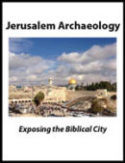The role of Khirbet Qeiyafa in the Judean foothills has long been questioned. The site’s importance, however, is doubtless. First proposed to be a mighty stronghold of King David, this tenth-century B.C.E. hilltop fortress has recently been reinterpreted by David Ussishkin, in the Israel Exploration Journal, to be a cultic compound. Enclosed by low, thick walls and looking down at the surrounding hills (the famed setting of the story of David and Goliath), initial interpretations of the site’s role as a defensive settlement were readily accepted. Yet scholars have continued to debate the site and now Ussishkin has proposed a new theory that has sparked the imaginations of scholars and the public alike.

Mighty fortress or cultic compound?
In his article, David Ussishkin, an archaeologist at Tel Aviv University, reevaluated interpretations of the archaeological finds from Qeiyafa. In particular, Ussishkin drew attention to the fact that Qeiyafa, a relatively small site of about 5.5 acres, had two gates in its outer wall instead of one. Why would a city built for so few people have two gates, as might be expected of a capital city like Jerusalem or Samaria?
Ussishkin proposes that the twin gates found at Qeiyafa might have aided the flow of pilgrims in and out of the city during ritual processions. Thus, he reimagines Qeiyafa as a pilgrimage site rather than a settlement. Moreover, Ussishkin argues that the contrast between the city’s foreboding walls and its easily accessed interior demonstrates the symbolic — rather than functional — importance of the city’s fortifications.
Many scholars, however, are pushing back against Ussishkin’s interpretation. As cited in a recent Haaretz article, scholars like Israel Finkelstein assert that Ussishkin’s proposal creates more questions than it answers. While they note that there are, indeed, some two-gated sites that seem to be cultic in nature, such as Ein Gedi near the Dead Sea, these sites show little evidence of domestic occupation. Khirbet Qeiyafa, by contrast, revealed abundant artifacts associated with daily life. What is more, relatively few ritual objects were identified at Qeiyafa.
What is clear is that Khirbet Qeiyafa continues to spark scholarly debate about its function and importance. Was Qeiyafa one of the last Canaanite strongholds, or does the fort’s proximity to Jerusalem indicate that it was a fortified citadel from the time of King David? Or, as is now suggested by Ussishkin, was the site a unique cultic compound from the tenth century? The debate will no doubt continue.
Read more in Bible History Daily:
Biblical Sha’arayim: Khirbet Qeiyafa’s Second Gate Discovered
All-Access members, read more in the BAS Library:
Newly Discovered: A Fortified City from King David’s Time
Rejected! Qeiyafa’s Unlikely Second Gate
Reviews: King David’s Stronghold at Khirbet Qeiyafa?
Not a BAS Library or All-Access Member yet? Join today.The post Khirbet Qeiyafa: David’s Fortress or an Ancient Cultic Center? appeared first on Biblical Archaeology Society.



0 Commentaires